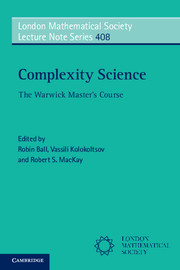
|
Complexity Science: The Warwick Master’s Course
by R. Ball, V. Kolokoltsov, and R. S. MacKay
New York, NY: Cambridge University Press
London Mathematical Society Lecture Note Series 408
445 pp. (2013)
ISBN: 978-1-107-64056-6
|
| |
Reviewed by: Mary Jean Amon
Complexity Laboratory, Department of Psychology
University of Cincinnati
Email: amonmj (at) mail.uc.edu |
A simple Google Ngram search of “
complexity science” makes evident the recent spike in interest in complex systems theory and methods. Consequently, works such as Ball, Kolokoltsov, and MacKay’s “Complexity Science: A Warwick Master’s Course” are timely and welcome additions to the burgeoning field. This text focuses on the mathematical tools essential for understanding complex systems. The book is part of the London Mathematical Society Lecture Note Series and provides an overview of a wide variety of concepts in complexity science defined in terms of mathematical prediction. Topics include self-organization, emergence, differential equations, partial differential equations, space-time phases, selfish routing, and stochastic methods. Examples drawn from different disciplines are interwoven into each chapter, providing insight into the various applications of complexity science.
Following a lecture-note format, each chapter begins by outlining the basic principles to follow. Brief sections often resemble a series of detailed PowerPoint slides taken from intermediate courses on complexity science. Sections typically include definitions complemented by their respective mathematical formulas. Using this format, the authors are able to cover an impressively wide array of topics within complexity science. The focus on mathematical principles also lends to an in-depth understanding of certain topics that other texts might only mention. For example, Brownian motion or random walks are often only briefly described in introductory texts. In contrast, “Complexity Science” explains Brownian motion in terms of its subtypes and basic properties, which are best explained in terms of probabilistic rules of behavior.
While the book covers a variety of principles common to complexity science, its format and focus lends itself to a niche audience. Because some concepts are covered rather quickly, it is ideal for the reader that has some knowledge of the subject. Readers new to complexity science would benefit from pairing the book with an introductory text or classwork that offers more of the conceptual fundamentals. The expertise of the authors draws the focus of the book to the mathematical principles underlying common concepts in complexity science. The text is therefore best suited for readers who have a background in calculus and linear algebra. The unique format of the London Mathematical Society Lecture Note Series makes this book particularly appropriate for those designing courses or looking to reinforce or test their own knowledge on the subject matter.
“Complexity Science” has a few limitations. First, because of the lecture-note format, sections can occasionally seem disjointed and abrupt. Concepts essential to understanding complexity science are sometimes covered only briefly. Consequently, it may be difficult to understand topics foundational to complexity science and the connections between them if this book is referenced as a standalone guide. The book could be accessible to a broader audience by including more extensive conceptual summaries and explaining the connections between topics. Second, it is important for a reader to understand the difference between a general text on complexity science and one on applied mathematics like “Complexity Science.” Methods utilized in the latter can differ from those used in experimental pursuits. For example, fractal analysis is an interdisciplinary method for studying complex systems. However, the present text covers this method only briefly by focusing on the calculation of a fractal dimension. Other commonly utilized research techniques, including spectral analysis, detrended fluctuation analysis, and adaptive fractal analysis are not covered, perhaps because they are not essential to understanding the mathematical principles of a fractal.
Anyone having a mathematical background and interest in complexity science will likely find the book wonderfully enriching. Novices to the field, however, could easily be left behind. Educators designing courses on the subject matter would especially benefit from viewing the brief notes and examples on a variety of topics. Similarly, given the breadth of material covered, readers from various disciplines who wish to enhance their understanding of complexity science will undoubtedly uncover new information and perhaps altogether new topics.